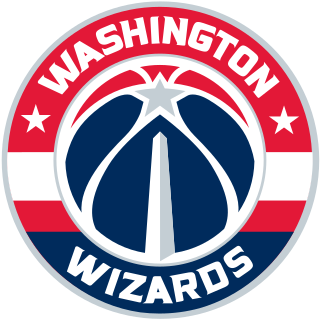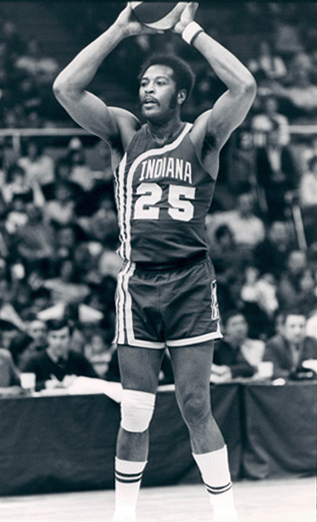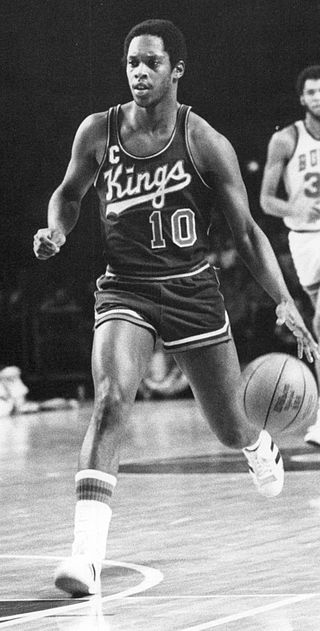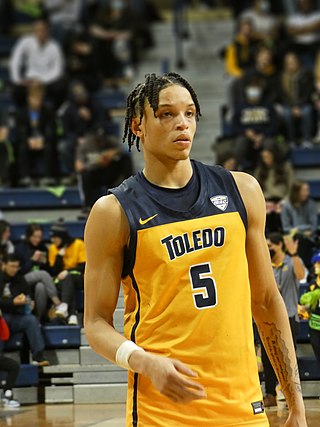
The Washington Wizards are an American professional basketball team based in Washington, D.C. The Wizards compete in the National Basketball Association (NBA) as a member of the Southeast Division of the Eastern Conference. The team plays its home games at Capital One Arena, in the Chinatown neighborhood of Washington, D.C. an arena they share with the Washington Capitals of the National Hockey League (NHL) and the Georgetown University men's basketball team. The team is owned by Ted Leonsis through Monumental Sports & Entertainment.

Vernon Earl Monroe is an American former professional basketball player. He played for two teams, the Baltimore Bullets and the New York Knicks, during his career in the National Basketball Association (NBA). Both teams have retired Monroe's number. Due to his on-court success and flashy style of play, Monroe was given the nicknames "Black Jesus" and "Earl the Pearl". Monroe was inducted into the Naismith Memorial Basketball Hall of Fame in 1990 and the International Sports Hall of Fame in 2013. In 1996, Monroe was named as one of the 50 Greatest Players in NBA History, and in 2021, Monroe was named as one of the 75 greatest players in NBA history.

Gus (Honeycomb) Johnson Jr. was an American college and professional basketball player in the National Basketball Association (NBA) and American Basketball Association (NBA). A chiseled 6 ft 6 in (1.98 m), 235-pound (107 kg) forward who occasionally played center, Johnson spent nine seasons with the Baltimore Bullets before he split his final campaign between the Phoenix Suns and ABA champions Indiana Pacers. He was a five-time NBA All-Star before chronic knee issues and dubious off-court habits took their tolls late in his career.

Moses Eugene Malone Sr. was an American professional basketball player who played in both the American Basketball Association (ABA) and the National Basketball Association (NBA) from 1974 through 1995. A center, he was named the NBA Most Valuable Player (MVP) three times, was a 12-time NBA All-Star and an eight-time All-NBA Team selection. Malone led the Philadelphia 76ers to an NBA championship in 1983, winning both the league and Finals MVP. He was inducted into the Naismith Memorial Basketball Hall of Fame in his first year of eligibility in 2001. Widely regarded as one of the greatest players in the sport's history, Malone is also seen as one of the most underrated NBA players.

Ralph Lee Sampson Jr. is an American former professional basketball player. He is a member of the Naismith Memorial Basketball Hall of Fame. A 7-foot-4-inch (2.24 m) phenom, three-time college national player of the year, and first overall selection in the 1983 NBA draft, Sampson brought heavy expectations with him to the National Basketball Association (NBA).

Nathaniel "Tiny" Archibald is an American retired professional basketball player. He spent 14 years playing in the National Basketball Association (NBA), most notably with the Cincinnati Royals/Kansas City–Omaha Kings and Boston Celtics. In 1991, he was enshrined into both the Naismith Memorial Basketball Hall of Fame and the New York City Basketball Hall of Fame.

Spencer Haywood is an American former professional basketball player and Olympic gold medalist. Haywood is a member of the Naismith Memorial Basketball Hall of Fame, being inducted in 2015.

Elvin Ernest Hayes, nicknamed "The Big E", is an American former professional basketball player and radio analyst for his alma mater Houston Cougars. He is a member of the NBA's 50th and 75th anniversary teams, and an inductee in the Naismith Memorial Basketball Hall of Fame. Known for both his offensive and defensive prowess, Hayes is often regarded as one of the best power forwards in NBA history. Hayes is also known for his longevity, being seventh all-time in NBA minutes played, and missing only nine games during his 16-season career.

Steven Charles Mix, nicknamed "The Mayor", is an American former professional basketball player and coach. Mix had a thirteen-year playing career, was an NBA All-Star and played in the NBA Finals on four occasions. He later had a lengthy career as a broadcaster for the Philadelphia 76ers.

John Warren Marin is an American former professional basketball player. A 201 cm small forward from Duke University, Marin was named to the 1967 NBA All-Rookie Team and spent 11 seasons in the National Basketball Association (1966–1977), playing for the Baltimore Bullets, Houston Rockets, Buffalo Braves and Chicago Bulls. The left-handed Marin was a two-time All-Star and scored 12,541 points in his career. He led the NBA in free throw percentage during the 1971–72 NBA season.
John Francis Egan was an American professional basketball player and coach. He played for the Detroit Pistons, New York Knicks, Baltimore Bullets, Los Angeles Lakers, Cleveland Cavaliers, and San Diego / Houston Rockets of the National Basketball Association from 1961 to 1972. He coached the Rockets from 1973 to 1976.

Donald R. Kojis was an American professional basketball player who played twelve seasons in the National Basketball Association (NBA). Kojis is credited as involved in the creation or advancement of the alley-oop dunk.

Kevin Robert Kunnert is an American former basketball player in the National Basketball Association (NBA). A 7'0" and 230 lb center–power forward, was drafted out of the University of Iowa by the Chicago Bulls in the first round of the 1973 NBA draft. He also helped the Houston Rockets to a Central Division title during the 1976–77 season.

Larry Jones is an American former professional basketball player. He most notably played in the American Basketball Association (ABA), where he was the first player to reach 5,000 career points. He also had shorter stints in the rival National Basketball Association (NBA).

The 1973 NBA draft was the 27th annual draft of the National Basketball Association (NBA). The draft was held on April 24 and May 5, 1973, before the 1973–74 season. In this draft, 17 NBA teams took turns selecting amateur U.S. college basketball players and other eligible players, including international players. The first two picks in the draft belonged to the teams that finished last in each conference, with the order determined by a coin flip. The Philadelphia 76ers won the coin flip and were awarded the first overall pick, while the Portland Trail Blazers were awarded the second pick. The remaining first-round picks and the subsequent rounds were assigned to teams in reverse order of their win–loss record in the previous season. Prior to the draft, the Baltimore Bullets relocated to Landover, Maryland, and became the Capital Bullets. The Philadelphia 76ers were awarded an extra first-round draft pick as compensation when the Seattle SuperSonics signed John Brisker. A player who had finished his four-year college eligibility was eligible for selection. If a player left college early, he would not be eligible for selection until his college class graduated. Before the draft, 11 college underclassmen were declared eligible for selection under the "hardship" rule. These players had applied and gave evidence of financial hardship to the league, which granted them the right to start earning their living by starting their professional careers earlier. The draft consisted of 20 rounds comprising the selection of 211 players.
The 1972 NBA draft was the 26th annual draft of the National Basketball Association (NBA). The draft was held on April 10 and 15, 1972 before the 1972–73 season. In this draft, 17 NBA teams took turns selecting amateur U.S. college basketball players and other eligible players, including international players. The first two picks in the draft belonged to the teams that finished last in each conference, with the order determined by a coin flip. The Portland Trail Blazers won the coin flip and were awarded the first overall pick, while the Buffalo Braves were awarded the second pick. The remaining first-round picks and the subsequent rounds were assigned to teams in reverse order of their win–loss record in the previous season. As a result of last year's supplemental hardship draft, the Cincinnati Royals, the Atlanta Hawks, the Golden State Warriors and the Baltimore Bullets forfeited their first-round picks, while the Los Angeles Lakers forfeited their fourth round pick. Prior to the start of the season, the Cincinnati Royals relocated and became the Kansas City-Omaha Kings. The draft consisted of 18 rounds comprising the selection of 198 players.
The 1967 NBA draft was the 21st annual draft of the National Basketball Association (NBA). The draft was held on May 3 and 4, 1967 before the 1967–68 season. In this draft, 12 NBA teams took turns selecting amateur U.S. college basketball players. A player who had finished his four-year college eligibility was eligible for selection. If a player left college early, he would not be eligible for selection until his college class graduated. The first two picks in the draft belonged to the teams that finished last in each division, with the order determined by a coin flip. The Detroit Pistons won the coin flip and were awarded the first overall pick, while the Baltimore Bullets were awarded the second pick. The remaining first-round picks and the subsequent rounds were assigned to teams in reverse order of their win–loss record in the previous season. Five teams that had the best records in previous season were not awarded second round draft picks. Two expansion franchises, the Seattle SuperSonics and the San Diego Rockets, took part in the NBA Draft for the first time and were assigned the sixth and seventh pick in the first round, along with the last two picks of each subsequent round. The draft consisted of 20 rounds comprising 162 players selected.

John Harding Lucas II is an American professional basketball coach and former player who most recently served as an assistant coach for the Houston Rockets of the National Basketball Association (NBA). He played basketball and tennis at the University of Maryland, College Park and was an All-American in both.
William G. Schaeffer is an American former basketball small forward in the American Basketball Association (ABA) for the New York Nets and Virginia Squires. He also was a member of the Allentown Jets in the Eastern Pennsylvania Basketball League. He played college basketball at St. John's University.

Ryan Anthony Rollins is an American professional basketball player for the Milwaukee Bucks of the National Basketball Association (NBA), on a two-way contract with the Wisconsin Herd of the NBA G League. He played college basketball for the Toledo Rockets.














